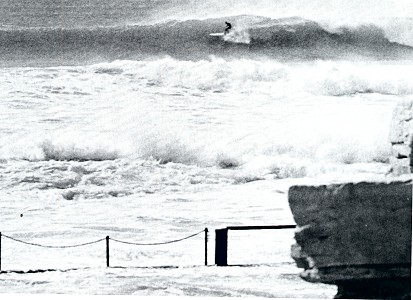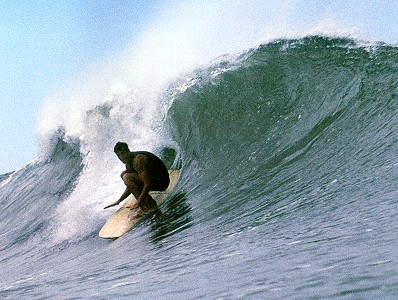 |
surfresearch.com.au
the catalogue #522 |
| home | catalogue | history | references | appendix |
|
|
|||||||||||||||||||||||||||||||||||||||||||||||||
 |
|||||||||||||||||||||||||||||||||||||||||||||||||
| MANUFACTURE
MANUFACTURER: Gordon Woods Surfboards Brookvale Sydney SHAPER: Nat Young DESIGN: 'Sam' -Thin rail Malibu DESIGNER: Nat Young GLASSER : Darryl Holmes |
|||||||||||||||||||||||||||||||||||||||||||||||||
| SPECIFICATIONS
CONSTRUCTION Foam blank with 1/2" redwood stringer, glassed in Volan with 2" rail lap. DIMENSIONS
Nose: Round, Tail: Square Deck: Flat Bottom: Flat nose. Rounded bottom, deepest in front of the fin. Rails:Thin egg rails Rocker: |
|||||||||||||||||||||||||||||||||||||||||||||||||
|
|||||||||||||||||||||||||||||||||||||||||||||||||
|
|||||||||||||||||||||||||||||||||||||||||||||||||

1. Nat Young and Sam, first surf. The Kick, Collaroy.
To maintain interest in the contest,Young offered to disregard the previous results, but this was unacceptable to the officials. Competition was continued with Nat Young again topping the score sheets. Other finalists were, in order, Jock Sutherland (Hawaii), Corky Carroll (USA), Midget Farrelly (Australia), Rodney Sumpter (UK) and Steve Bigler (USA). Despite competing for the U.K (his place of birth), Rodney Sumpter learnt his surfing skills on the northern Sydney beaches in the early 1960's. This was not the frst, or last, time he competed against Nat Young and Midget Farrelly. Duke Kahanamoku officiated at the awards ceremony, 4th October 1966 Sam disappeared during the post contest celebrations. 
3. Nat and Sam Pre-contest training, Santa Barbara From Bob McTavish : Pods for Primates, Tracks Magazine, 1972.... Cabell really impressed some with his opposite approach. His thing was to stuff himself into (the) curl at every opportunity, foresaking almost anything to do it, then dress up the situation with a noseride if possible. This meant the wave became everything, every nuance and change in the rate of peel had to be answered. He rode high, swooping out of the top to accelerate, trimming it through, then stepping up to hold i.t back in there as long as he could. This approach captured the imagination of those that had the nice waves to work on, so up at Noosa it got going, with (Bob) Cooper, Russell Hughes, Algie Grud, myself, Kevin Platt, making the boards to suit at Hayden's (Surfboards). Shorter, 9'-
9' 6" fuller throughout, thin rails, finer. Cabell's model made at McDonagh's
was the
So that was
the thing that was going in Aussieland in 1966. Shortish, 9'-9'6", 221/2
wide, hot dog
Initially derived from a Joey Cabell design, it developed at the Noosa sessions late 1965 with George Greenough, Bob McTavish, Russell Hughes and Bob Cooper, based at Hayden Surfboards, and subsequently Cord Surfboards, Alexandria Headlands. Many Australian designers were producing similar designs – all of those mentioned above and Midget Farrelly (see Stringerless model), Keith Paull, Bobby Brown, Peter Drouyn, and others; but Nat Young’s win saw the design exposed internationally as well as becoming the accepted common design in Australia. Since the design directly preceded the sub 9ft Vee-bottom design, it is now considered the last of the original Malibus/Longboards. Design known in New Zealand as a Thin Rail. Not to be confused with a mid-1980's Modern
Malibu design by Nat Young featured a Sam - an old friend
decal, manufactured by Mike Davis Surfboards, Kiama and others.See
below.
Magazines
Paul Holmes : In
Trim - Nat Young,
Paul Gross (ed) :
Moving
Forward - A Greenough Scrapbook 1960 -1970
John Brasen : Greenough's
Scrapbook
Film
McGillray and Freeman
: Free and Easy, 1967
Dale Davis : The
Golden Breed, 1968
Boards
|
|||||||||||||||||||||||||||||||||||||||||||||||||


|
|||||||||||||||||||||||||||||||||||||||||||||||||

surfresearch.com.au |
| home | catalogue | history | references | appendix |